|
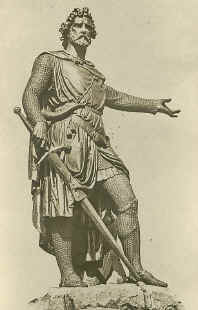 The land of Scotland has dictated what sort
of history its people would have. The Scots have mountains and marshes;
long, narrow, steep-sided glens, all too often open to north-west winds;
acid soil and a climate which sees the seasons overlapping, the only
certainty being that the growing season will be short. Here the Scots have
had to do the best they could with what they had, and all through their
history, with hard work and much ingenuity, they have managed to make the
land serve its people better than might have been expected. The land of Scotland has dictated what sort
of history its people would have. The Scots have mountains and marshes;
long, narrow, steep-sided glens, all too often open to north-west winds;
acid soil and a climate which sees the seasons overlapping, the only
certainty being that the growing season will be short. Here the Scots have
had to do the best they could with what they had, and all through their
history, with hard work and much ingenuity, they have managed to make the
land serve its people better than might have been expected.
As well as the land there is the sea. No
one in Scotland is very far from the sea, and even if the actual oceans
are at some distance, there are long sea lochs, their waters probing into
the heart of the country, and there are rivers widening out into firths.
The sea and the lochs and the firths have
often served as a defence - moats, as it were, behind which the Scots
might shelter. But, important for strategy and defence as they were, these
waters were also routes for trade and international contacts. The waters
which were so often a barricade, could easily become roads, along which
traders and administrators travelled to carry out their tasks. Until as
recently as, say, 1960, the traditional and most convenient method of
entry to towns and villages all along the shores of the west coast of the
country and the western shores of the Firth of Clyde was by sea.
So, the nature of the land had largely
determined how, and how successfully, the Scots would make their living
and organise their activities. But in yet another respect their
experiences were dictated by the residence which fate had given them. All
through historic times the Scottish people have had to share an island
with another people, far stronger than they in all respects - more
numerous, more wealthy and usually more advanced technologically,
especially in methods of warfare. Consciously and instinctively the Scots
have always had to live with this fact, and their first and constant
political problem has been how they might best co-exist with the English.
Different solutions to this problem have been adopted at different times,
or have been urged by competing Scottish factions at the same time. In
either case the Scots have had to make up their minds whether their
interests are best served by collaboration with English objectives and
English power, and an acceptance of the fact of English dominance in
Britain, or whether they should resist absorption, and make the
preservation of their national identity a priority. It is the supporters
of this latter policy who find grimly humorous accuracy in the remark of a
Scottish writer in modern times that the Scots needed the Alps, but God
had given them the Cheviots.
And what of the people of this land? Who
are the Scots? Like any other people in modern times they are the
descendants of every settler who ever lived here. They are a nation of
immigrants, even though their immigrant ancestors came many centuries ago,
some beyond recorded time. Humans came to Scotland, following the
retreating ice some 8000 years ago. The earliest pioneering visitors were
probably exactly that - visitors, from the European mainland, driven by
hope and curiosity, by ambition and chance, to gather plants and hunt
living things for food. In due course, no doubt, some of these visitors
were content with what they had found, and saw the prospect of a
satisfactory future in this newly found land. So they settled, not at
first in any recognisable permanent communities, but living rather a
nomadic life passing the days and years and generations in fishing and
hunting along the shores, and sometimes entering, greatly daring, the
forests of the interior. By 6000 years ago there were certainly permanent
inhabitants who are the first ancestors of the Scots.
As time passed, later waves of visitors and
settlers arrived, bringing with them new genes, new skills and new
customs; adding to the ability of the natives to use implements of bone,
wood and stone, the knowledge of metal-working in bronze and iron;
offering as a means of livelihood not just hunting, gathering and herding,
but crop growing - agriculture in the proper sense. Once the skills of
seed-time and harvest were acquired, settlement in the real sense of
permanent residence in selected sites was possible.
Our knowledge of how and when this sequence
of events took place can never be wholly satisfactory, because all this
happened before written records, and even before oral tradition can be
used to fill the gap which the absence of written evidence leaves. Our one
source of information is the science of archaeology. Archaeologists have
done - and continue to do - wonders in providing the rest of us with our
awareness of the remote past, but there are, inevitably, limits to what
this can tell us. The identification of a site of historic interest is
largely a matter of luck, however informed and perceptive the searcher may
be; and the excavation of such a site is costly in time and money. We have
to accept the evidence of the archaeologist in much the same way as one
accepts the evidence of modern political scientists using samples to point
to probabilities.
The sites discovered and excavated are the
archaeologist's samples. From the shells and fish bones in the middens
buried under the sands of Tentsmuir in Fife, we learn of the presence and
survival methods of our earliest natives. From the discovery of a
hollowed-out log or dugout canoe in the bed of the River Tay we deduce
that men were able, using such vessels, to make sea-borne journeys. At the
wonderful site of Skara Brae in Orkney we can see preserved the stone
skeleton of a village, 4000 years old, buried under the sand by one gale,
and laid bare by chance, after almost 4000 years, by another. From such
sites we can learn what these ancestors of ours ate and wore; from the
articles and ornaments found we can make deductions about their society;
and when we find the graves where they buried their dead or their cremated
ashes, we can even have a modest awareness of their beliefs.
We can use this kind of evidence to
identify the variety of peoples, arriving at different times, because
their goods are new and different and because their dead are buried in
different fashion in tombs of different structure and dimensions. Even the
poor exposed skeletons tell the story of a variety of peoples with
differing physical characteristics, all of whom came to live here. We can
begin to see, in the mind's eye, a kind of parade of the earliest,
primitive hunters, the more skilled agriculturalists, and the
metal-working Beaker folk, who buried their dead in individual tombs,
leaving with each the vessels and implements which might be found useful
in the after life which they obviously expected.
That there was a spiritual side to the life
of all these people, the barrows and occucists testify; as also, most of
all, do the great stone circles like those at Brodgar
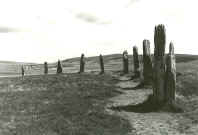
The Ring of Brodgar,
Stenness, Orkney. (Photo: Gordon Wright)
in Orkney or Callanish in Lewis. These
sites are signs of a conscious and deliberate decision, by people of whom
we know so little, to raise symbols of honour and respect. As time passed
these symbols came to bear carvings, proving that an artistic instinct had
developed and was here revealed.
These then were our ancestors. They were
not unique. Those who came here had come from somewhere else, and there
they had left behind their kindred. The distinctiveness of the Scots is
not therefore to be found in any one genetic origin, but rather in the
blending of all these components which occurred here and, in these
proportions, here alone.
We are inclined to form wrong impressions
of what would happen as successive waves of invaders descended upon the
people already in possession of the land. It is easy to assume that
invaders would go in for massacre and extermination, but a little
commonsense should lead us to calmer and more accurate judgement.
For one thing, while some victims of the
attack will die in heroic resistance, and others, more lucky, will run
away, the vast majority simply stay where they are and make the best of a
bad job. The conquerors, for their part, don't want corpses, they want
workers, servants, perhaps slaves, but at least useful, living
subordinates.
Also when conquest and occupation by
intruders first happens, the intruders are almost by definition, warrior
bands and thus male. As well as land and property, victorious men will
seize upon women by right of conquest, and will claim them as their mates.
After the initial attacks had occurred and a new dominant group had
established itself, the future lay with people whose parentage was part
native and part conqueror.
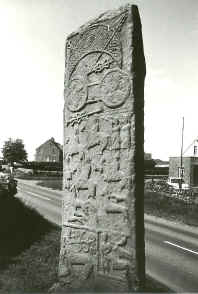
Pictish stone, Aberlemno,
near Brechin. (Photo: James Halliday)
The conquerors, to be sure, would impose
their kind of society, their customs, and, especially, their language; but
they could not and did not eradicate the people they had conquered. They
dominated and ruled, but that is not the same as destroying those now at
their mercy.
We can see this pattern unfolding when we
turn to consider the group of invaders who next came to Britain, because
we are in a position to know much more about them than we can possibly
know of the earliest peoples.
For knowledge of these earliest inhabitants
we have to rely upon archaeology and scientific deductions, but the new
invaders have left an oral and, eventually, a written record from which we
can draw understanding.
These new invaders, arriving some 2500
years ago, were members of the Celtic racial group, coming from the
north-western parts of Europe, and at least kindred of, if not wholly
identical to, the Gauls who then held those lands. They were of the
Brythonic branch of the Celtic peoples, or 'P' Celts, so called because
their language commonly employed labial consonants, p, b, v and so on, in
words like 'pen' = 'head' and 'ap' = 'son of'. They established their
supremacy over the land and its existing inhabitants, becoming a kind of
aristocracy and imposing their ways and their languages. The now
subordinate natives, most of them, lived on, but their language did not.
Only fragments of any pre-Celtic speech remain, particularly in place
names. (After all the oldest named things in the world are the mountains
and rivers and other natural features upon which humans have looked since
mankind's earliest days.)
Of the people themselves we lose track,
meeting them probably in the stories and legends of their Celtic
conquerors. Celtic folk-lore is rich in stories of strange secret people,
dwelling in remote parts of the country; secretive, furtive, shunning the
daylight. These small, dark folk, brownies, elves, fairy folk, are
probably the unassimilated survivors of the pre-Celtic peoples.
As for the Celts, they applied to
themselves the name 'Pretani'. And when the next invaders arrived they
seem to have heard the name and adopted it, with only a slight error in
pronunciation, and called the people they found, 'Britoni'.
The new invaders, the Romans, were of
course very different from previous settlers. In the first place they
weren't really settlers at all, and had not been prompted to come to
Britain by land hunger, ambition or flight from even more ferocious
intruders into their own homelands. They were the masters of the European
and Mediterranean world, and they came as masters to extend their power
and assert their authority over one of the few parts of the world which
they did not yet own. Their role was like that of governors and
administrators, and commercial entrepreneurs; they had not come to farm or
to work, merely to rule those who did.
They conquered and subdued the Celtic-ruled
tribes, beginning in the south of the island and moving gradually north.
By around 80 AD they were active as far north as the Solway and Tweed, and
on the passes over the Cheviots. But the further north they went the more
difficult it was to keep their legions supplied and controlled from their
great depots and garrison centres at York and Chester.In the year 80 AD,
the Roman governor, Julius Agricola, struck northwards from the Solway/Tyne
line, and began a campaign intended no doubt to bring the northern tribes
into the same degree of subjection as their kin in the south. Four main
tribes stood in his path. In the east, between the Tweed and the Forth,
were the Votadini, and their stronghold on Traprain Law. Westwards of
there lay the territory of the Selgovae; and further west still, in the
valley and estuary of the Clyde, were the Novantae and the Damnonii. Only
the Selgovae appear to have sought seriously to obstruct Agricola's
advance, and caused him to build what became a major fort, at Newstead -
the Roman 'Trimontium', nestling as it did at the foot of the three peaks
of the Eildon Hills.
With these tribes subdued, Agricola
advanced further north, and controlled the Forth/Clyde isthmus with a line
of forts. From this base in 84 AD he marched northwards, along the only
route which geographical conditions then made feasible; across the Carron,
then the Forth near the site of Stirling, in the territory of the Maeatae,
and then to the Tay at its highest navigable point, present day Perth.
Beyond the Tay his legions moved
northwards, his supply ships moving in parallel with his army, and making
contact every so often to replenish supplies. Eventually his advance
brought him to the spot, never yet acceptably identified, called Mons
Graupius. There the northern tribes, united it seems in resistance, stood
at bay; and their leader Calgacus called on his men to resist to the last
against the Romans and their plans which Calgacus saw would involve the
ruin and destruction of their society. The Roman future he rejected, in
the phrase which Tacitus has made famous, 'Where they make a desert, they
call it "peace''.
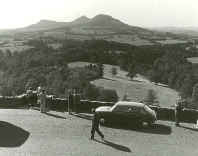
The Eildon Hills from Scott's
View. (Photo: Gordon Wright)
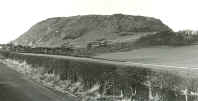
Traprain Law, East Lothian.
(Photo: Gordon Wright)
Agricola won the battle, but total conquest
and occupation of the north proved beyond his capacity. The best he could
do was to have small forts to keep watch at the mouths of the glens which
gave access into and from the further mountain regions.
Before his term of duty ended he had
constructed these outposts; the forts along the Forth and Clyde, and a
network of forts and roads along which reinforcements and supplies could
be brought as required. But the Roman presence in these parts was of short
duration. The main Roman frontier from around 120 AD was defined by
Hadrian's Wall, and north of that wall there was a very limited civilian
presence. A final attempt was made by Lollius Urbicus, the Roman governor
in 142-3 AD, who tried to make a more substantial and permanent wall along
the Forth/Clyde line, which was named the Antonine Wall in honour of the
Roman emperor of the day. This wall was built of turf on a base of stone,
and was some 14ft. wide. It had forts at roughly two-mile intervals along
its length, and the most impressive signs of a settled Roman way of life
are to be found at these strong points.
But the Romans did leave behind them, more
important than roads and forts, baths and villas, the experience and the
memory of Christianity. The earliest Christians in Britain were soldiers
and their families, or officials serving the legions and their
organisations in some capacity. There are Christian signs at several
sites, dating from the earliest days of the Antonine Wall, and for over a
century before Roman rule ended in Britain, the Empire had been officially
Christian. For a few brief years in the mid-fourth century the area
between the Walls was once more brought under Roman control, and during
that period there was born, into a Christian society, the first known
Christian evangelist in our history, St Ninian.
Born in the Solway area, and educated,
according to tradition, in Rome, the young Ninian spent time in the
monastic community led by St Martin near Tours. Returning home, some time
before 400 AD, he established his stone church 'Candida Casa' at Whithorn
which served as a centre of missionary activity carried on by Ninian and
his followers. So when we speak of Christianity being brought to Britain
in the sixth century, by St Columba or St Augustine, we speak carelessly,
and with thoughtless disregard for what was Rome's most profound legacy to
our country.
There are limits, which should be obvious,
to what walls can and cannot do. Separation over a period of generations
can create differences in society, and even in speech, on either side of
the wall which creates the separation. But in real essentials the people
on either side remain as they were before the wall was built. If the wall
is built through the lands of a single people, then biologically a single
people they remain.
All people in Britain when the Romans
arrived had a common ancestry, and retained it, regardless of any wall or
action by the Romans. Sometimes the Latin writers mention, as a kind of
alternative name for the Caledonians, 'the Picts', and much energy has
been expended in seeking to answer the question 'Who were the Picts?'. The
commonsense view has to be that the Picts were merely the Britons who had
avoided incorporation into Rome's empire; and the Britons, throughout the
island, were all the descendants of all who had gone before. Some
differences there would be as a result of distances and isolation of one
tribe from another, and very likely, pre-Celtic influences would survive
more strongly in one part of the island than in another. Latin and English
writers have led us into imagining some mysterious racial divisions where
none really existed. The Wall separated people physically, when the
sentries wished it to do so, but it could not undo the natural work of
generations.
A useful corrective to these errors can be
found in writing which is neither Latin nor English, but Welsh - the great
epic The Gododdin which tells of the ride of the warriors of the
Votadini - The Gododdin in other words - to the aid of their British kin
at the great battle of Catraeth (Catterick). Kin all Britons still
remained, and not the Antonine Wall, or even Hadrian's Wall, could alter
that fact.
Not until post-Roman times did any new race
intrude into the island, adding to the genetic pool of its people. In the
latter years of the Roman occupation various raiders from overseas had
carried out hit and run raids around the coasts. As Roman power declined
the ability of its rulers to provide for the defence of its remoter
provinces lessened, until finally, after several forlorn attempts to avoid
the decision, the legions were withdrawn from Britain altogether in the
year 407 AD.
The departure of the Romans meant that hit
and run raiders might now find it possible - and tempting - to see
themselves as settlers, and perhaps conquerors; and throughout the rest of
the fifth century two such groups gradually established themselves in
Britain.
From Scotia - the north eastern part of
Hibernia (or Ireland) - came the Scots, a Celtic people like the Britons,
but of a different branch of the family. They were Gaelic, not Brythonic,
their speech categorised as 'Q' Celt rather than 'P' Celt, as they used
guttural consonants 'c' and 'g' rather than the 'p' and 'b' of the earlier
arrivals. Thus the Brythonic 'pen' is, in Gaelic, 'ceann', and 'ap'
becomes 'mac'.
From Ireland access to the western coasts
and islands of northern Britain was easy, and the journey no problem
whatever to galley-borne fighting men. Scots over a period of time
established settlements at various points throughout the inner Hebrides
and around the sea lochs and firths; and by 500 they had arrived and
concentrated in sufficient strength, to have created for themselves the
Kingdom of Dalriada. This land had been until its seizure, the home of
British/Pictish tribes, and was no doubt looked upon as national territory
by the Pictish Kings. So, there would be anger and battles as the Scots
sought to penetrate further inland, and the resentful Picts sought to keep
them out. On the evidence of surviving place-names we can see a pattern to
the eventual extent of the Scottish conquest. Obviously there was no
clearly defined boundary, such as modern states would establish, but the
Scottish advance can be seen to have halted along the high ground known
anciently as 'Drumalban' where modern Argyle meets the shires of Inverness
and Perth.
In the generations which followed, Scottish
power and influence moved gradually east and north-east, carried forward
often no doubt, by war, but owing much to the work and influence of the
first truly historical Scot, St Columba.
Columba - Columcille in his own language -
was a prince of the royal house in Irish Dalriada, who had to leave his
home after a dispute over, so tradition tells us, the copying of a
Christian psalter. The dispute had caused bloodshed, and blame seems to
have been laid upon Columba who left Ireland for exile in Scottish
Dalriada in 563. There, on the island of Iona, already a traditional place
of Christian worship, he and his group of followers made their home and
began the mission work which made the little island one of the most
influential and loved centres of Christendom.
As well as being a Christian evangelist
Columba was also a Scot, and, we may guess, a patriotic one. His
fellow-Scots had only recently suffered a defeat in the long-running war
with the Picts. Perhaps if the Pictish king could be won over to
Christianity like the Scots, enmity between the two would diminish and
harmony prevail. Possibly with this part-religious part-diplomatic
purpose, Columba and a few colleagues (two of them themselves Picts) set
off along the Great Glen to meet and negotiate with the Pictish King Brude
at Inverness.
This mission was successful, and a shared
Christian affiliation now promised better relations between Picts and
Scots. For the rest of his life Columba, and the followers whom he taught
and inspired, carried their mission and this Scottish influence into much
of Pictland, including Orkney and the Western Isles. He also established
friendly contacts with fellow-Christians in British territory south of the
Clyde, inheritors of the tradition begun by St Ninian, especially St.
Mungo (or Kentigern) who, we are told, received Columba as a visitor in
Glasgow in 584.
By the time of his death in 597 Columba had
served his faith with great devotion and success, but he had also proved a
wise counsellor to the Scottish Kings of Dalriada and his legacy to his
fellow countrymen was political as well as religious.
Britons and Picts were more or less the
same people by blood at least, with the latter perhaps retaining slightly
more traces of their pre-Celtic ancestors. The Scots were more distantly
related, but still related. But in the dying days of Roman Britain there
appeared around the coasts yet another wave of invaders, with no ancestral
or cultural ties to the Britons at all. These were the English - known
variously as Angles, Saxons and Jutes - who first established themselves
in the south and south-eastern coastal areas of Britain. Their settlements
gradually extended along the east coast, as later fleets brought over more
settlers from their German homelands; and by 597 there was an English
stronghold north of Hadrian's Wall, at Bamborough.
As English power grew, and strongholds
established links with one another, by around 590 they had cut a corridor
right across the island from the North Sea to the Irish sea, separating
the Britons of the north from their brothers in what became Wales. Their
northern expansion brought them into war against an alliance of Britons
and Scots; and the English victory at Degsastane (possibly near Jedburgh)
in 603 gave them control of the eastern coast as far north as the Forth.
The eastern boundary was for the moment
well-defined; but there was no necessity to imagine that the Forth must be
the river along which Pict and Englishman would bristle at each other. The
border might move south to the Tweed, or the Tyne or the Wear - perhaps
even the Humber. On the other hand it might move north to the Tay or the
Moray Firth.
On the west, the question was whether the
Britons might succeed in reuniting, or whether at least they might hold
the whole area north of the line of the Ribble. The alternative was that
the English might widen their corridor, and push the boundary to the
Solway or even to the Clyde.
The crucial fact however was that the
English had succeeded in cutting off the native-cum-Celtic peoples in the
north of the island from their kindred in the west and south-west. As it
turned out this division was never to be reversed. The future fate of the
sundered sections was to be very different and the northern section was in
due course to emerge as Scotland. |

